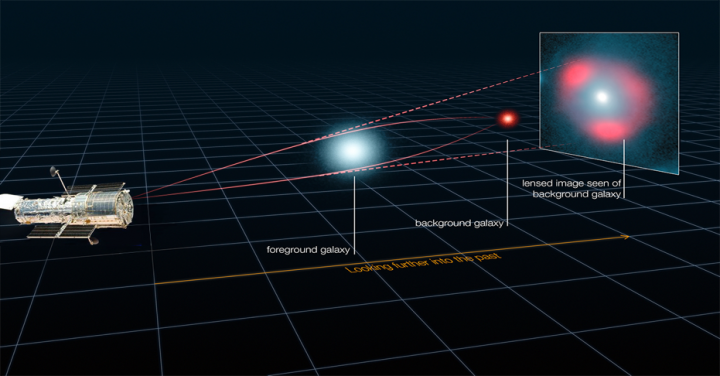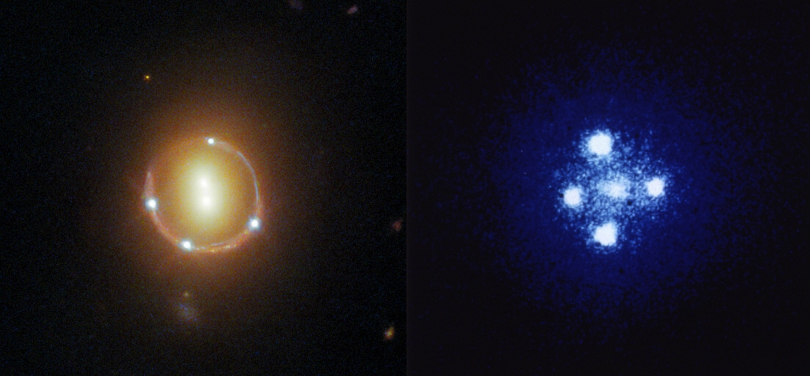Media
HKU Astrophysicists Reveal the Nature of Dark Matter
through the Study of Crinkles in Spacetime
25 Apr 2023

Figure 3: Visualisation of smooth versus crinkly spacetime produced by different forms of Dark Matter around galaxies. Left: Dark Matter comprising ultramassive particles create a smooth curvature in spacetime, such that light from a distant lensed galaxy takes smooth paths around the foreground lensing galaxy. Right: Dark Matter comprising ultralight particles creates crinkly fluctuations in spacetime, such that light from a distant lensed galaxy takes chaotic paths around the foreground lensing galaxy. The multiple images of the background galaxy thus created are predicted to have different positions and brightness for the different forms of Dark Matter around the lensing galaxy, allowing astrophysicists to probe the nature of Dark Matter.

Figure 1: Illustration of gravitational lensing by a galaxy. Light from a more distant and reddish galaxy is bent by a more nearby and bluish galaxy, which acts like a natural cosmic telescope to magnify the more distant galaxy. In this instance, multiple images of the reddish galaxy are created, forming a reddish ring-like feature referred to as an Einstein ring around the bluish galaxy.
(Image credit: ALMA, L Calcada, Y. Hezaveh et al.)

Figure 2: Examples of gravitational-lensed images observed with the Hubble Space Telescope. Left: 2M130-1714, in which the four bright and bluish points comprise the quadruply-lensed images of the bright nucleus of a background galaxy, such that the main body of the background galaxy is lensed and distorted into an Einstein ring. The Einstein ring encircles two yellowish galaxies comprising the foreground lensing galaxies. Image credit: NASA/ESA/Hubble/T.Treu/Judy Schmidt. Right: The Einstein Cross, comprising four bright points corresponding to the quadruply-lensed images of the bright nucleus of a background galaxy. The fifth point near the middle of the cross corresponds to the foreground lensing galaxy.
(Image credit: NASA/ESA/STSci)

Figure 3: Visualisation of smooth versus crinkly spacetime produced by different forms of Dark Matter around galaxies. Left: Dark Matter comprising ultramassive particles create a smooth curvature in spacetime, such that light from a distant lensed galaxy takes smooth paths around the foreground lensing galaxy. Right: Dark Matter comprising ultralight particles creates crinkly fluctuations in spacetime, such that light from a distant lensed galaxy takes chaotic paths around the foreground lensing galaxy. The multiple images of the background galaxy thus created are predicted to have different positions and brightness for the different forms of Dark Matter around the lensing galaxy, allowing astrophysicists to probe the nature of Dark Matter.

Figure 1: Illustration of gravitational lensing by a galaxy. Light from a more distant and reddish galaxy is bent by a more nearby and bluish galaxy, which acts like a natural cosmic telescope to magnify the more distant galaxy. In this instance, multiple images of the reddish galaxy are created, forming a reddish ring-like feature referred to as an Einstein ring around the bluish galaxy.
(Image credit: ALMA, L Calcada, Y. Hezaveh et al.)
- 1 / 3
- 2 / 3
- 3 / 3
Most of the matter in the universe, amounting to a staggering 85% by mass, cannot be observed and consists of particles not accounted for by the Standard Model of Particle Physics (see remark 1). These particles are known as Dark Matter, and their existence can be inferred from their gravitational effects on light from distant galaxies. Finding the particle that makes up Dark Matter is an urgent problem in modern physics, as it dominates the mass and, therefore, the gravity of galaxies – solving this mystery can lead to new physics beyond the Standard Model.
While some theoretical models propose the existence of ultramassive particles as a possible candidate for Dark Matter, others suggest ultralight particles. A team of astrophysicists led by Alfred AMRUTH, a PhD student in the team of Dr Jeremy LIM of the Department of Physics at The University of Hong Kong (HKU), collaborating with Professor George SMOOT, a Nobel Laureate in Physics from the Hong Kong University of Science and Technology (HKUST) and Dr Razieh EMAMI, a Research Associate at the Center for Astrophysics | Harvard & Smithsonian (CFA), has provided the most direct evidence yet that Dark Matter does not constitute ultramassive particles as is commonly thought but instead comprises particles so light that they travel through space like waves. Their work resolves an outstanding problem in astrophysics first raised two decades ago: why do models that adopt ultramassive Dark Matter particles fail to correctly predict the observed positions and the brightness of multiple images of the same galaxy created by gravitational lensing? The research findings were recently published in Nature Astronomy.
Dark Matter does not emit, absorb or reflect light, which makes it difficult to observe using traditional astronomical techniques. Today, the most powerful tool scientists have for studying Dark Matter is through gravitational lensing, a phenomenon predicted by Albert Einstein in his theory of General Relativity. In this theory, mass causes spacetime to curve, creating the appearance that light bends around massive objects such as stars, galaxies, or groups of galaxies. By observing this bending of light, scientists can infer the presence and distribution of Dark Matter – and, as demonstrated in this study, the nature of Dark Matter itself.
As illustrated in Figure 1, when the foreground lensing object and the background lensed object – both constituting individual galaxies in the illustration – are closely aligned, multiple images of the same background object can be seen in the sky. The positions and brightness of the multiply-lensed images depend on the distribution of Dark Matter in the foreground lensing object, thus providing an especially powerful probe of Dark Matter.
Another assumption of the nature of Dark Matter
In the 1970s, after the existence of Dark Matter was firmly established, hypothetical particles referred to as Weakly Interacting Massive Particles (WIMPs) were proposed as candidates for Dark Matter. These WIMPs were thought to be ultramassive – more than at least ten times as massive as a proton - and interact with other matter only through the weak nuclear force. These particles emerge from Supersymmetry theories, developed to fill deficiencies in the Standard Model, and have since been widely advocated as the most likely candidate for Dark Matter. However, for the past two decades, adopting ultramassive particles for Dark Matter, astrophysicists have struggled to correctly reproduce the positions and brightness of multiply-lensed images such as those shown in Figure 2. In these studies, the density of Dark Matter is assumed to decrease smoothly outwards from the centres of galaxies in accordance with theoretical simulations employing ultramassive particles.
Beginning also in the 1970s, but in dramatic contrast to WIMPs, versions of theories that seek to rectify deficiencies in the Standard Model, or those (e.g., String Theory) that seek to unify the four fundamental forces of nature (the three in the Standard Model, along with gravity), advocate the existence of ultralight particles. Referred to as axions, these hypothetical particles are predicted to be far less massive than even the lightest particles in the Standard Model and constitute an alternative candidate for Dark Matter.
According to the theory of Quantum Mechanics, ultralight particles travel through space as waves, interfering with each other in such large numbers as to create random fluctuations in density. These random density fluctuations in Dark Matter give rise to crinkles in spacetime, as illustrated in Figure 3 below for the Dark Matter surrounding galaxies. As might be expected, the different patterns of spacetime around galaxies depending on whether Dark Matter constitutes ultramassive or ultralight particles – smooth versus crinkly – ought to give rise to different positions and brightness for multiply-lensed images of background galaxies, as illustrated in the same figure.
In work led by Alfred AMRUTH, a PhD student in Dr Jeremy LIM’s team at HKU, astrophysicists have for the first time computed how gravitationally-lensed images generated by galaxies incorporating ultralight Dark Matter particles differ from those incorporating ultramassive Dark Matter particles.
Their research has shown that the general level of disagreement found between the observed and predicted positions as well as the brightness of multiply-lensed images generated by models incorporating ultramassive Dark Matter can be resolved by adopting models incorporating ultralight Dark Matter particles. Moreover, they demonstrate that models incorporating ultralight Dark Matter particles can reproduce the observed positions and brightness of multiply-lensed galaxy images, an important achievement that reveals the crinkly rather than smooth nature of spacetime around galaxies.
‘The possibility that Dark Matter does not comprise ultramassive particles, as has long been advocated by the scientific community, alleviates other problems in both laboratory experiments and astronomical observations,’ explains Dr Lim. ‘Laboratory experiments have been singularly unsuccessful at finding WIMPs, the long-favoured candidate for Dark Matter. Such experiments are in their final stretch, culminating in the planned DARWIN experiment, leaving WIMPs with no place to hide if not found (see remark 2).’
Professor Tom BROADHURST, an Ikerbasque Professor at the University of the Basque Country, a Visiting Professor at HKU, and a co-author of the paper adds, ‘If Dark Matter comprises ultramassive particles, then according to cosmological simulations, there should be hundreds of satellite galaxies surrounding the Milky Way. However, despite intensive searches, only around fifty have been discovered so far. On the other hand, if Dark Matter comprises ultralight particles instead, then the theory of Quantum Mechanics predicts that galaxies below a certain mass simply cannot form owing to the wave interference of these particles, explaining why we observe a lack of small satellite galaxies around the Milky Way.’
‘Incorporating ultralight rather than ultramassive particles for Dark Matter resolve several longstanding problems simultaneously in both particle physics and astrophysics,’ said Amruth Alfred, ‘We have reached a point where the existing paradigm of Dark Matter needs to be reconsidered. Waving goodbye to ultramassive particles, which have long been heralded as the favoured candidate for Dark Matter, may not come easily, but the evidence accumulates in favour of Dark Matter having wave-like properties as possessed by ultralight particles.’ The pioneering work used the supercomputing facilities at HKU, without which this work would not have been possible.
The co-author Professor George SMOOT added, ‘Understanding the nature of particles that constitute Dark Matter is the first step towards New Physics. This work paves the way for future tests of Wave-like Dark Matter in situations involving gravitational lensing. The James Webb Space Telescope should discover many more gravitationally-lensed systems, allowing us to make even more exacting tests of the nature of Dark Matter.’
Remarks:
1. The Standard Model of Particle Physics is the theory describing three of the four known fundamental forces (electromagnetic, weak and strong interactions — excluding gravity) in the universe and classifying all known elementary particles. Although the Standard Model has met with huge successes, it leaves some phenomena unexplained – e.g., the existence of particles that interact with known particles in the Standard Model only through gravity – and falls short of being a complete theory of fundamental interactions.
For more information, please check here: https://home.cern/science/physics/standard-model
2. Last chance for WIMPs: physicists launch all-out hunt for dark-matter candidate:
https://www.nature.com/articles/d41586-020-02741-3
The journal paper can be accessed here:
https://www.nature.com/articles/s41550-023-01943-9 (Subscription required)
https://rdcu.be/damHj (Online version)
The video on the research can be found at: https://youtu.be/DV8MH2bDsEE
More information about the research team of Dr Jeremy Lim: https://www.scifac.hku.hk/kwok/sal/jlim/
Images download and captions: https://www.scifac.hku.hk/press
For media enquiries, please contact Dr Jeremy Lim (email: jjlim@hku.hk); Mr Alfred Amruth (email: h1352888@connect.hku.hk); Ms Casey To, External Relations Officer (Tel: 3917-4948; email: caseyto@hku.hk ) and Ms Cindy Chan, Assistant Communications Director of Faculty of Science (Tel: 3917-5286; email: cindycst@hku.hk ).
